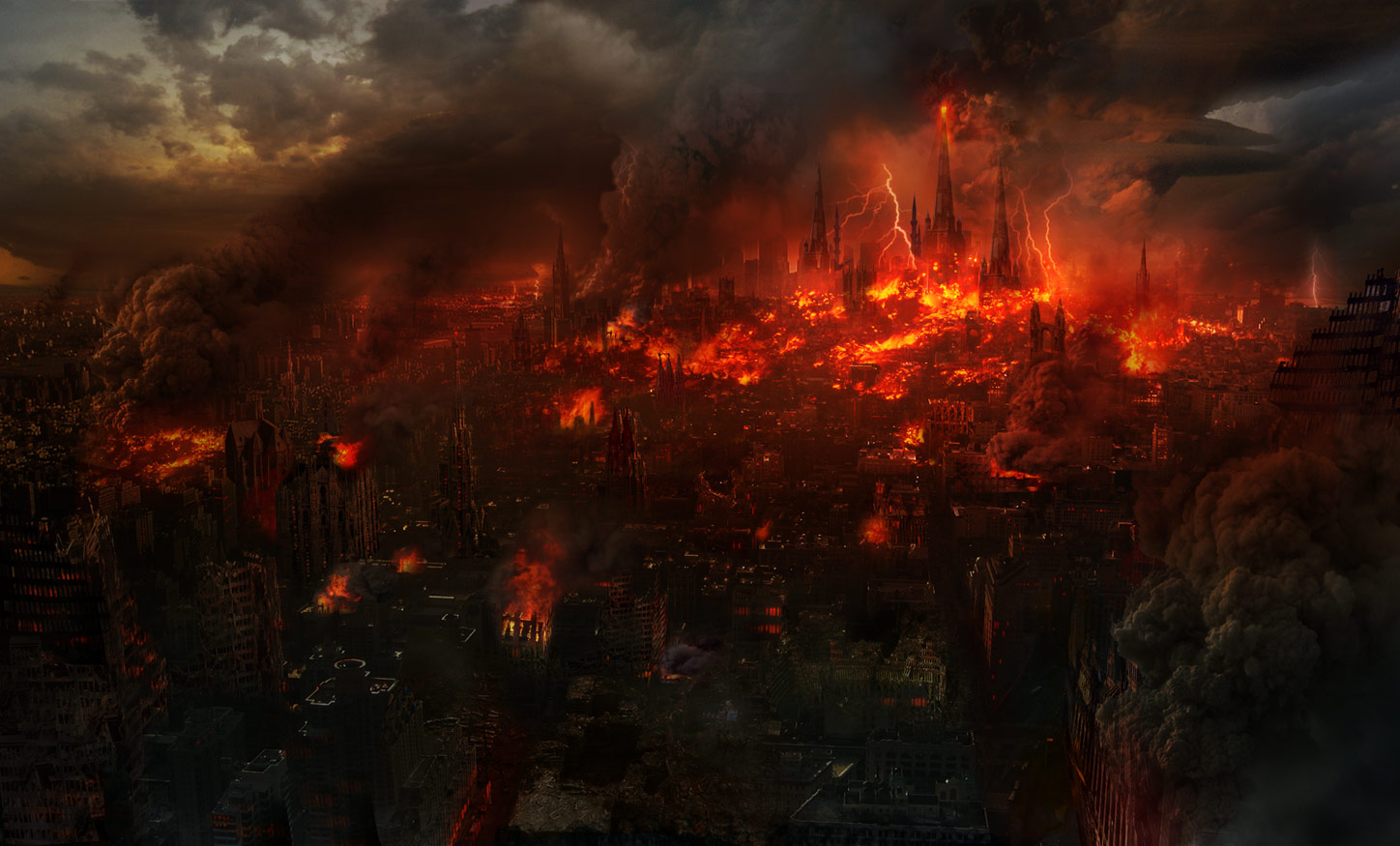By request, repost of 2008 blog (now defunct) on literary evolution of Hell in the bible:
In the synoptic Gospels, Hell is usually described as a realm of fire, a place that seemingly judges and punishes at the same time, (Matthew 5:22, 29–30; 10:28; 18:9; 23:15, 33; Mark 9:43, 45, 47; Luke 12:5). The most commonly used word for “hell” in the scriptures is the Aramaic word “Gehenna” that passed directly into Greek. Gehenna literally means “Valley of Hinnom” (In Hebrew, “Geh Hinnom”). The Valley of Hinnom was originally a piece of the Promised Land, a lowland (now to the southeast of Jerusalem’s Old City), given to the Hinnom family after whom it was named (Joshua 15:8 and 18:16).
In light of passages that speak of the judgment upon Israel’s enemies in a valley near Jerusalem (Isaiah 30:29–33; 66:24; Joel 3:2, 12, 14) and the worship of Molech in the Valley of Hinnom, the valley became known as a fiery place of judgment. Gehenna was both a place of eschatological judgment in the environs of Jerusalem and an otherworldly place of judgment for the wicked.
So, how does a piece of the Promised Land become hell on earth, “where the worm never dies, and the fire is never quenched”? (Mark 9:48) The short answer is that we did it. Human beings transformed God’s good creation into hell. Let me say now that I am not concerned with the issue as to whether or not hell exists, or will exist, in a metaphysical sense. I am exploring the evolution of hell as a literary metaphor in the bible. It helps me to make sense of what I see as current manifestations of hell on earth in Darfur and Congo [originally in 2008. Today I think of all the placed trafficked women and girls are being abused, especially Chad and Nigeria].
Jeremiah (7:31) tells us that people burned their children alive in the Valley of Hinnom – the first mention of fire associated with the infamous valley. Even Judean kings, Ahaz (2 Chronicles 28:3) and Manasseh (2 Chronicles 33:6), immolated their children there. Human beings committed atrocities against the most vulnerable among us. Women and men murdered children, their own children.
In the rest of the scriptures and intertestamental literature – Judith, 2 Esdras, Enoch and the Gospels – Gehenna, hell, is a by-word. The biblical writers use Gehenna/hell the way many used place-names like Auschwitz, Beirut, Sarajevo, Bosnia and Rwanda years ago, and the way in which some invoke Darfur and Congo contemporarily.
A concept of the afterlife was developed during the Hellenistic Period, including the notion of a fiery judgment (1 Enoch 10:13; 48:8–10; 100:7–9; 108:4–7; Judith 16:17; 2 Baruch 85:13), a judgment usually in a fiery lake or abyss (1 Enoch 18:9–16; 90:24–27; 103:7–8; 2 Enoch 40:12; 2 Baruch 59:5–12; and in Qumran, in the Thanksgiving Scroll, 1QH 3). The Valley of Hinnom, often referred to simply as “the accursed valley” or “abyss,” eventually came to represent the place of eschatological judgment of the wicked by fire (1 Enoch 26–27; 54:1–6; 56:1–4; 90:24–27).
By at least the 1st century C.E. Gehenna was understood metaphorically as the place of judgment by fire for all wicked everywhere (Sibylline Oracles 1.100–103; 2.283–312). The judgment of the wicked occurred either as a casting of their soul in Gehenna immediately upon death or as a casting of the reunited body and soul into Gehenna after the resurrection and last judgment (2 Esdras 7:26–38/4 Ezra 7:26–38; Ascent of Isaiah 4:14–18; Sibylline Oracles 4.179–91). This key understanding separated Gehenna from its geographical location, but retained its fiery nature. Gehenna had become hell as we know it.
The biblical, literary, trajectory of the Valley of Hinnom from a piece of the Promised Land to a place of perpetual punishment is instructive. It offers the possibility that Hell is not a preordained construct created by God, but a human construction. The Hinnom Valley was created along with all other dry ground, and its vegetation sprouted on the third day of creation with the rest of earth, and presumably, it too was ‘good’ (Genesis 1:10-13). It was given to the Hinnom family as part of the divine promise. (No mention was made of previous inhabitants.) And some five hundred years later, monarchs burned their children alive in acts they understood as religious devotion. It is likely that unknown numbers of unknown Israelites and Canaanites also sacrificed their children there, and sent their children to a hell of their own making, but the chronicles of Israel are not the chronicles of ordinary folk, so we do not know their stories.
In rabbinic thought, as early as the 1st century, Gehenna was understood as both an intermediate place of punishment for the souls of the wicked between death and resurrection to final judgment, and as the place of final judgment for the reunited body and soul of the wicked (Midrash Tehillim 31.3). According to this reasoning, most Jews would be spared Gehenna completely, and most of those who do enter it in the intermediate state would be released from it, with the exception of historic reprobates, adulterers, or those who shame or vilify others (b. Rosh HaShannah 16b–17a). It was a fiery purgatory for those Jews whose merits and transgressions balanced one another (t. Sanhedrin 13.3) who would afterward be admitted to Paradise. Often the punishment of Gehenna was restricted to 12 months (m. {Eduyyoth 2.10; S. {Olam Rab. 3; b. Qiddushin 31b). However, the punishment for Gentiles in Gehenna was eternal. The epithet “child of Gehenna” is used in the Talmud (b Rosh HaShannah 17b) as it is in Matthew 23:15.
It occurs to me, that we as human beings have not finished making hell. In the decades and centuries to come, Auschwitz, Rwanda, Darfur and Congo may well replace Gehenna in public discourse as designations for hell; in many ways, they already have. And I suggest, that the gates of Jerusalem may be understood as the very gates of hell. For just as the ancient walls of Jerusalem opened to the Valley of Hinnom, so too does the new wall (a.k.a. ‘security barrier’) dividing Israelis and Palestinians circumscribe not just the geographicalGeh Hinnom/Gehenna, but also a living hell for both the Palestinian and Israeli people –living today in the same small land whose geography, culture and theology once gave birth to Christian notions of hell.
The burning children of Canaan, ancient and contemporary Israel, Auschwitz, Rwanda, Darfur, Congoand Palestine are calling us who stand outside the fires of hell to do “tikkun olam,” the rabbinic expression for “repairing the world,” and usher in the reign of God.
In the Lukan Gospel (17:21), Jesus says, “in fact, the dominion of God is among you.” I believe that the inverse is also true; the dominion of hell is among us. If it is true that human evil ushered hell into this world, does it not lie within us to transform the most hellish places on earth into arable valleys and suburbs?
Lastly, I want to comment on my use of “we” and “us.” I don’t think that anyone reading this column perpetrated atrocities in any of the places that I have named. But I do believe that we as human beings are responsible for each other: we are our sisters’ keeper and we are our brothers’ keeper. It is not enough for us to proclaim that our hands are clean of the blood – and ashes – of the innocent. This world is given into our care. Now, what are we going to do about it?


Valerie
May 23, 2014 12:29 amAmen!
Chris Cocca
May 23, 2014 12:32 amreally interesting. well done.